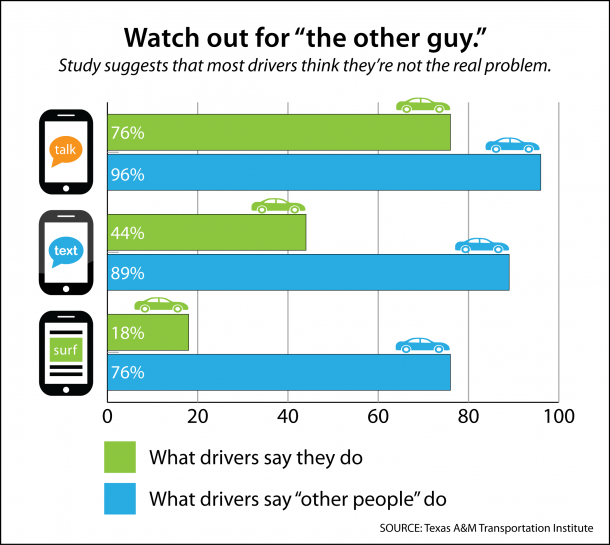 Three-fourths of Texas drivers in a recent survey say they have talked on a cell phone behind the wheel within the past month, about the same number as those who reported speeding. Nearly half say they have texted while driving, slightly more than the number who ran a stop sign or red light.
Three-fourths of Texas drivers in a recent survey say they have talked on a cell phone behind the wheel within the past month, about the same number as those who reported speeding. Nearly half say they have texted while driving, slightly more than the number who ran a stop sign or red light.
Financial services provider USAA asked the Texas A&M Transportation Institute (TTI) to conduct the study to research attitudes and reported driving behaviors of drivers throughout Texas. The study, which was conducted between April 25 and May 30, 2013, utilized two different research methods to gain better insight on Texans’ opinions about distracted driving. The researchers first used a questionnaire in driver license offices around the state to gain a one-time, broad look at Texans’ driving habits. Focus groups were then used to collect more detailed answers on distracted driving issues.
Out of eight driving habits including speeding, texting, driving through red lights, talking on the cell phone and drunk driving, 76 percent of participants reported that they had talked on the cell phone at least once in the last month. The second most often reported behavior was exceeding the speed limit by 5 mph at 74.2 percent. Texting and driving was third with 44.2 percent of participants reporting they had read or written a text while driving in the last month. Respondents were also asked to report on other distracted driving activities they participate in while driving. The most frequently reported behavior that was considered to be more dangerous than being on a cell phone was eating while driving, which was reported by 25 percent of those who answered the question.
A majority of participants in the study – 53 percent – disagreed with the statement “I am able to multi-task well while driving.” However, of that 53 percent, only 12 percent indicated that they “do not answer the phone while driving,” and 38 percent answered “I do not look at messages while driving.”
The survey also questioned participants about the risks involved with distracted driving behaviors. The number-one action deemed risky by participants was driving while intoxicated, with 90.3 percent of respondents giving it a highest risk rating. In comparison, 63.4 percent of these respondents said texting while driving was in the highest risk category. Overall, respondents were more likely to say that talking on a cell phone was not as dangerous as texting while behind the wheel. However, talking or texting while driving was considered safer when stopped at a traffic light or stop sign than when the car was actually in motion.
The survey also asked respondents how other drivers behave while driving. Although 76 reported talking on the phone themselves, nearly all participants – 95.6 percent – believed that other drivers do. 65.3 percent disagreed with the statement “most people can drive well enough to take care of distractions quickly without being dangerous.”
Participants were given a list of 13 countermeasures designed to address unsafe driving, and asked to rank their top 5 priorities. For the top priority, stronger laws against driving while intoxicated were considered the most important by 23.3 percent of participants who favored stronger enforcement and 20.9 percent who favored stronger penalties. Next in line came laws against texting while driving, with 16.7 percent considering it the highest priority. A cell phone ban was not considered a high priority among respondents, although participants generally supported a ban on texting while driving.
Focus groups were held in Austin, College Station and Dallas, where researchers focused on participants’ opinions about distracted driving.
Most participants viewed cell phone use for talking while driving as common and acceptable – sometimes even beneficial or necessary – and all three groups agreed that texting is more distracting than talking on a cell phone because texting takes a driver’s eyes off of the road. Those who were most opposed to texting and driving either had experienced a tragedy involving distracted driving, knew personally of someone who had, or were affected by a tragedy portrayed in the media. Participants named drinking and driving, driving too slow, drag racing, not paying attention, and especially texting and driving as unacceptable driving behaviors.
Katie Womack, project director for the research, said studies like this one help researchers understand what steps need to be taken to address transportation safety issues.
“With more than 3,000 crashes in Texas a year in which cell/mobile phone use is a contributing factor, the study of attitudes and behaviors related to this issue is important work,” Womack said. “The bottom line is we need more study and meaningful data to guide efforts toward reducing these crashes.”
Understanding and Addressing Distracted Driving In Texas: A report to USAA
Texas Tribune article: Study: Most Texans Drive and Talk; Many Text